RDP 2023-08: The Evolution of Consumer Payments in Australia: Results from the 2022 Consumer Payments Survey 8. Other Payment Methods
November 2023
- Download the Paper 2.30MB
8.1 Consumer awareness and use
In recent years, several other ways to make payments – besides cash, cards or cheques – have emerged in Australia. The CPS gathered respondents' knowledge and usage of a number of these other ways to make payments. Knowledge and usage of these different payment methods varied widely among respondents (Figure 34). PayPal, a type of digital wallet, and BNPL had near universal consumer awareness. In contrast, consumers had little awareness of Beem (a digital wallet with the ability to split money with friends) and Alipay/WeChat Pay (mobile payment services), and usage in Australia was also low. Many people were aware of cryptocurrencies, but only a very small share had used them to make a payment in the past year.
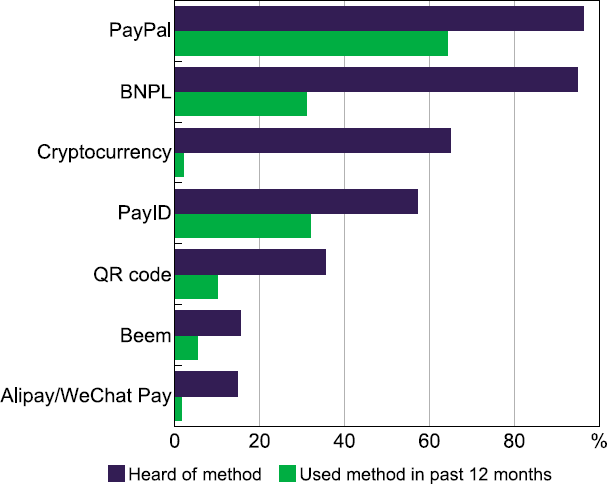
Source: RBA calculations, based on data from Ipsos.
The 2022 CPS asked respondents for the first time about their awareness of using quick-response (QR) codes for making payments. Some merchants now offer QR codes that direct consumers to a mobile wallet, typically funded by the consumer's debit or credit card, to complete a payment at the terminal. About one-third of respondents had heard of this payment method and around 10 per cent reported using it to make a payment in Australia in the past year. In some other countries, merchants are providing QR codes that allow their customers to pay by transferring funds directly from their bank account through fast payment systems. Adoption of this payment method in Australia could provide consumers with an alternative to card payments.
If participants in the CPS had heard of but not used an alternative payment method, they were asked about their reasons for not using it. Most of these respondents reported that their existing payment methods met their needs. For example, 50 per cent of people who were aware of BNPL said their existing methods met their needs; concerns about privacy and/or security and spending control were other commonly cited reasons for not using BNPL (Figure 35). Those who had not used cryptocurrency or QR code payments were relatively more likely to cite a lack of knowledge or tools, as well as concerns about privacy and/or security.
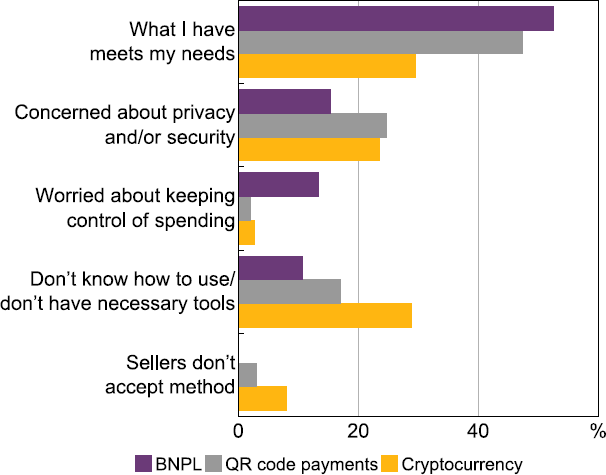
Note: Bars do not sum to 100 per cent as respondents could choose more than one answer and response of ‘Other reason’ not shown.
Source: RBA calculations, based on data from Ipsos.
8.2 Cryptocurrency payments
While only just under 2 per cent of respondents had used cryptocurrency to make a payment in the past year, 11 per cent of consumers reported holding cryptocurrency.[15] Males, especially those under 30, were the most likely to hold cryptocurrency (Figure 36). Even among males under 30 that held cryptocurrency, only a small share had made a payment using cryptocurrency in the past year. The low share of holders that had made a payment with cryptocurrency may reflect the large transaction fees for cryptocurrency transactions as well as little merchant acceptance in Australia. In addition, holders of cryptocurrency may be more driven by a desire for investment returns or hedging against inflation rather than using it as a payment method (Weber et al 2023).
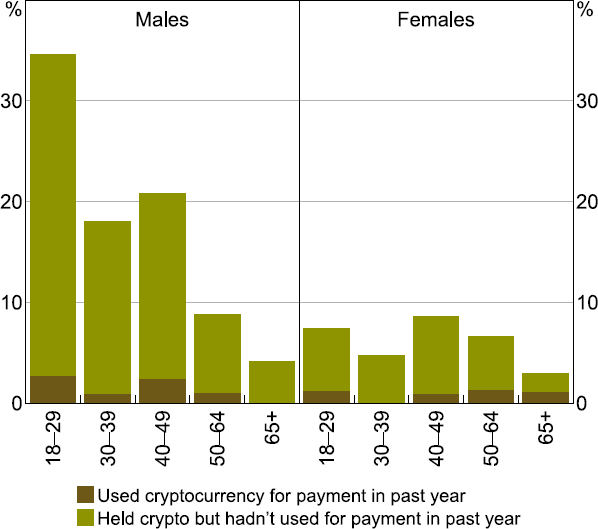
Source: RBA calculations, based on data from Ipsos.
8.3 Buy now, pay later
BNPL services allow customers to purchase goods on credit and make interest-free instalment repayments. While offering benefits for consumers, BNPL services are typically an expensive way for merchants to accept payments, costing on average around 4 per cent of the value of the transaction, compared with an average of around 0.5–1.5 per cent for traditional card payments. Almost one-third of Australians had used a BNPL service in the past year, up around 8 percentage points from 2019. Usage was highest among younger Australians: over 40 per cent of 18–39 year olds had used a BNPL service in the past year, compared with only 10 per cent for those aged 65 and over (Figure 37). Usage increased across all age groups from 2019. While a large share of Australians had used BNPL in the past year, BNPL payments made up just 0.7 per cent of the number of payments in 2022 up from 0.5 per cent in 2019.
Credit cards and BNPL services both allow customers to purchase goods on credit, and some consumers may use BNPL services as a substitute for credit cards. For instance, consumers that use BNPL are less likely to own a credit card, and this is true across most age groups (Figure 38). This may partly reflect that consumers who are not eligible for a credit card may use a BNPL service instead. In contrast to credit card issuers, BNPL services have not typically conducted thorough assessments of creditworthiness such as checking customers' incomes, assets and expenses.
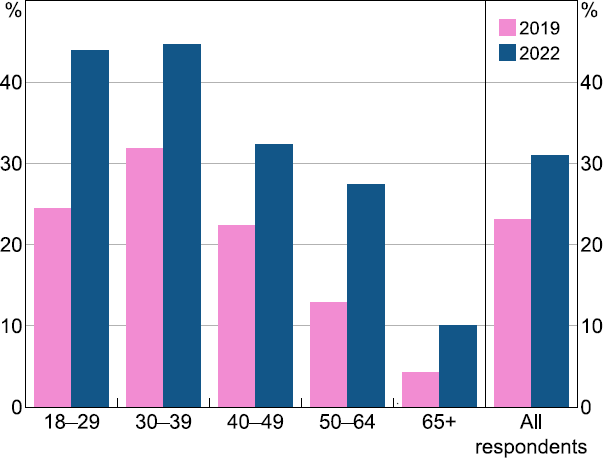
Source: RBA calculations, based on data from Ipsos and Roy Morgan Research.
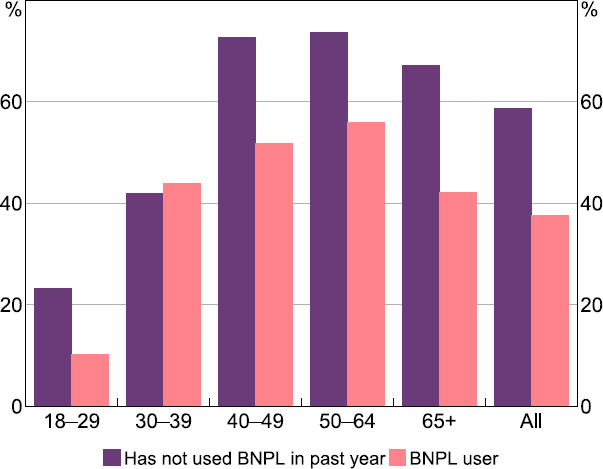
Source: RBA calculations, based on data from Ipsos.
For the first time, the 2022 CPS also collected data on the number of BNPL accounts consumers had with different BNPL providers. On average, Australians had 0.7 BNPL accounts per person, with people aged 18–39 having nearly one account on average (Figure 39, left panel). Those aged 65 and over were the least likely to hold a BNPL account. Of those consumers with a BNPL account, BNPL users held two accounts on average (Figure 39, right panel). Consumers with access to multiple accounts may encourage competition in the BNPL market, as providers compete to entice consumers to use their service. However, BNPL firms typically do not allow merchants to pass on the high cost of accepting their service directly to BNPL users through a surcharge. So, the benefits of competition in the BNPL market may accrue to BNPL users, subsidised by non-users as merchants recoup the cost by raising the price of goods and services generally.
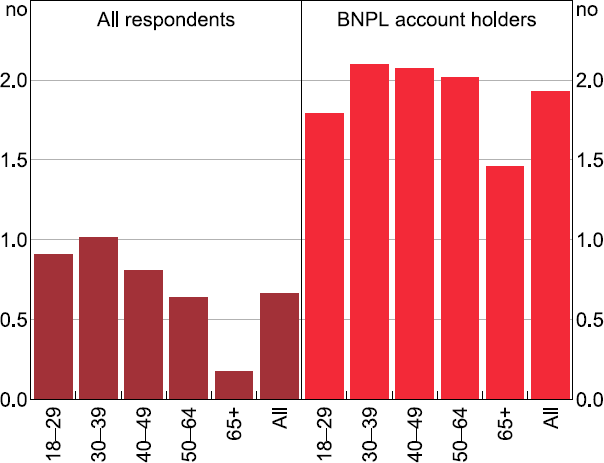
Source: RBA calculations, based on data from Ipsos.
8.4 Account-to-account payments, PayID and digital wallets
The way in which people can make account-to-account payments has changed significantly because of the introduction of new technologies. Since its launch in February 2018, the NPP has allowed customers of more than 90 financial institutions to make fast data-rich payments 24 hours a day; over 88 million Australian bank accounts are able to make and/or receive payments through the NPP (NPP Australia 2022). Separately, mobile apps have been developed to facilitate quick and easy transfers to friends and family (e.g. Beem) and even provide pocket money.
A significant innovation of the NPP has been the introduction of PayID. It allows account-to-account bank transfers to be addressed using a mobile number, email address or Australian Business Number (ABN). In 2022, around half of Australians had heard of PayID and 30 per cent had used it in the past year (Figure 34). PayID is more convenient than using the traditional Bank State Branch (BSB) and account numbers, which require consumers to correctly key in 15 digits. Another benefit of PayID is that the payer receives confirmation of the name of the person or business being paid, reducing the risk of fraud. PayID was introduced in 2018 as part of the NPP. Consumer uptake of PayID has been slower than initially expected, and currently not all Australian bank accounts are connected to make or receive a payment using PayID (Connolly 2022). In the diary, payments using PayID made up around 10 per cent of bank transfers, with the remainder addressed using BSB and account numbers (Figure 40). Consumers under the age of 50 had the highest share of bank transfers addressed using PayID.
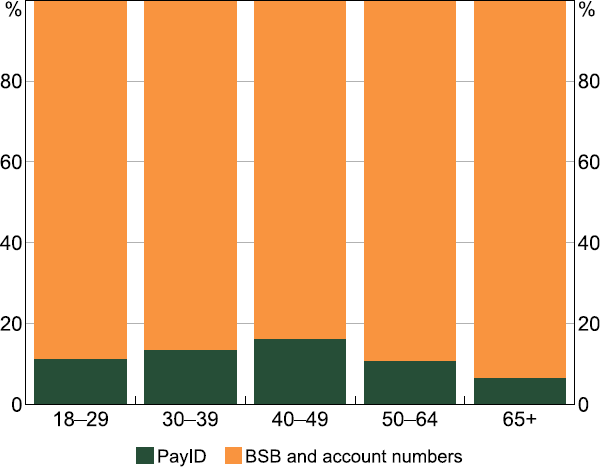
Note: Excludes transfers to family and friends, and transfers within own accounts.
Source: RBA calculations, based on data from Ipsos.
Among consumers that had heard of PayID but not used it in the past year, most felt that their existing payment methods met their needs (Figure 41). Some respondents also didn't know how to use or didn't have the necessary tools to use PayID. This could reflect that some institutions have not yet rolled out PayID. Among institutions that had rolled out PayID, many do not advertise the benefits to their customers or give much guidance on how to use PayID.
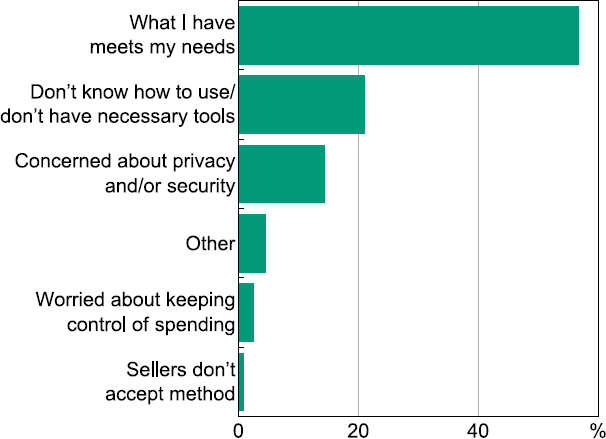
Source: RBA calculations, based on data from Ipsos.
New payment technologies have also facilitated a shift to transferring money to family and friends electronically using mobile apps rather than providing cash. The overall number of peer-to-peer transfers has been steady at around 2 per cent of consumer payments since 2013. The share of these transfers made using mobile and app-based methods has been steadily rising and accounted for over half of transfers in 2022 (Figure 42).[16] The increase in the use of mobile technology for transfers has been led by younger age groups, with respondents aged under 30 making three-quarters of their peer-to-peer transfers using apps.
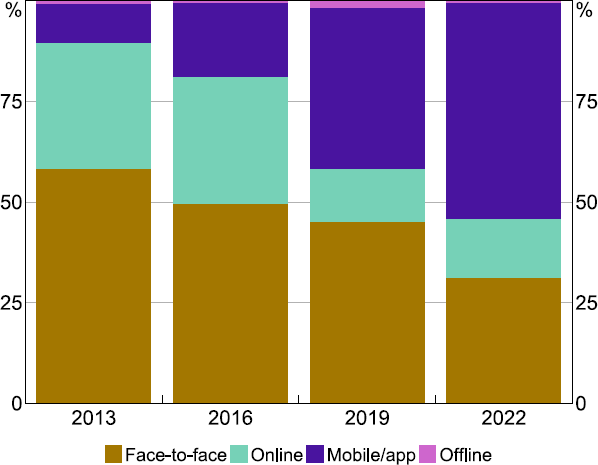
Source: RBA calculations, based on data from Colmar Brunton, Ipsos and Roy Morgan Research.
8.5 Transport cards
Since the 2019 survey, the CPS has collected information on the use of pre-paid transport cards such as Myki and Opal.[17] These types of cards have been rolled out across many public transport systems in Australia. More recently some public transport terminals have enabled fares to be paid directly by tapping a debit or credit card or mobile device on the terminal rather than a specific transport card. In the interest of ensuring comparability with previous survey waves, the analysis in the preceding sections does not include payments made with transport cards. In 2022, these payments were equivalent to 0.7 per cent of the number of consumer payments, down from 2 per cent in 2019. Besides increased use of payment cards and mobile devices directly on public transport terminals, the decline in transport card use may have been caused by increased working from home following the pandemic. For instance, usage of public transport in Australia was below pre-pandemic levels in 2022 (see Nicholas (2023) or Roy Morgan (2023)).
Footnotes
Respondents were instructed to exclude payments made to buy or sell cryptocurrency for investment purposes. [15]
The definition of an app-based payment has changed over survey years. In 2019 and 2022, the CPS asked whether consumers made a payment online or through an app. In 2016 and 2013, consumers were asked if a payment was made online by a smartphone/SMS payment. [16]
Survey waves prior to 2019 captured ‘top-ups’ of transport cards, rather than when the card was used for an individual trip; since 2019, the CPS captures both top-ups and individual transport card use. [17]